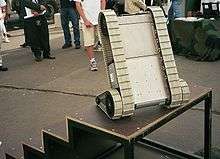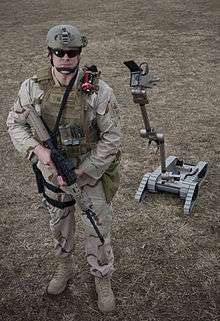PackBot

PackBot is a series of military robots by iRobot. More than 2000 were used in Iraq and Afghanistan.[1] They were then used again to aid searching through the debris of the world trade center after 9/11 in 2001.[2] PackBots were the first robots to enter the damaged Fukushima nuclear plant after the 2011 Tōhoku earthquake and tsunami.[3] As of November 2014, the U.S. Army is refurbishing 224 iRobot 510 robots.[4]
iRobot
A brief history of the iRobot company:[5]
- 1990 – Colin Angle, Helen Greiner, and Rodney Brooks found iRobot.
- 1998 – iRobot establishes a DARPA contract leading to the PackBot.
- 2001 – iRobot PackBot used to search World Trade Center ruins after the 9/11 attacks.
- 2002 – PackBot first deployed to aid United States Troops.
- 2004 – iRobot wins a contract to create Small Unmanned Ground Vehicles (SUGV).
- 2005 – iRobot begins trading stock.
- 2009 – SPARK education initiative.
- 2012 – Defense and security robots used worldwide passes 5,000.
NASA and PackBots
The National Aeronautic and Space Administration (NASA) has a partnership with the company, iRobot. NASA’s Jet Propulsion Laboratory (JPL) is a facility responsible for the development of robotic space-crafts as well as the Deep Space Network.[6] Among these space-crafts are the rovers sent to the planet Mars. The rovers Spirit and Opportunity sent to Mars in 2003 are just two of the rovers managed by the Jet Propulsion Laboratory. Mars is not the only place employing iRobot technology. In 2011, Japan was rocked by a strong earthquake causing a meltdown of the Fukushima nuclear reactor. Two PackBot rovers were deployed into the ruins of the nuclear power plant to assess damage where the radioactivity was at high enough levels prohibiting humans from exploring.
The projects involving the cooperation of iRobot and NASA allowed the creation of high-tech machines. The much needed physical structure of the robots was designed by iRobot while the instruments and science equipment onboard was provided by NASA’s Jet Propulsion Laboratory.[7]
Current PackBot 510 variants

PackBot 510 is the current base model. It uses a videogame-style hand controller to make it more familiar to young operators. Configurations include:
- PackBot 510 with EOD Bomb Disposal Kit designed for improvised explosive device identification and disposal.
- PackBot 510 with Fast Tactical Maneuvering Kit designed for infantry troops tasked with improvised explosive device inspection. This is a lighter weight robot.
- PackBot 510 with First Responder Kit designed to help SWAT teams and other first responders with situational awareness.
- PackBot 510 with HazMat Detection Kit collects air samples to detect chemical and radiological agents.
- PackBot 510 with Fido utilizes the Fido Explosives Detector from ICx Technologies as a payload in order to "sniff" out explosive materials. With the Fido, the PackBot now has the capability of locating explosive devices and subsequently disarming them using on-board robotic capabilities.[8]
- PackBot 510 with REDOWL Sniper Detection Kit utilizes the Acoustic Direction Finder from BioMimetic Systems to localize gunshots with azimuth, elevation, and range.[9]
- RC2 – U.S. Marine Corps version of the 510 PackBot with a longer and stronger arm, more cameras, communications variations, and better track propulsion.[10]
Packbot Performance
Packbot 510 has a maximum speed of 5.8 mph or 9.3 km/h, and weighs 31.6 lbs. or 14.3 kg.[11] The robot can traverse mud, rocks, stairs, and other surfaces due to its caterpillar track.[12] The robot also has zero radius turn capability and can climb up to a 60 degree incline. The dual BB-2590/U Li-ion rechargeable batteries allow for the robot to have a run time of 4 to 8 hours, and can maneuver in up to 3 feet of water.[12] Packbot has more than 40 accessories which are illustrated in Packbot 510 variants. Additionally, the robot can communicate up to 1000 meters or 3281 feet and captures information through four cameras with night vision, zoom, and illumination capabilities that allow for real time image processing.[13]
Previous PackBot variants

- PackBot Scout is the basic configuration. It has five payload bays for assignable purposes and can be dropped from a height of six feet (1.83m) onto concrete without being damaged. The Packbot scout version weighs about 40 pounds (18 kg).
- PackBot Explorer has a camera head equipped with multiple cameras, laser pointers, audio and other sensors.
- PackBot EOD (explosive-ordnance disposal) can be controlled by radio or wired control to handle situations involving potential explosives, thereby reducing the risk of personal injury.
Commercial Presence
iRobot, the company that produces PackBot isn't only known for creating military grade robots; they also have plenty of commercial robots on the market. These commercial robot's use some of the same technology as the PackBot's. Beginning in 2002 with the introduction of the Roomba- a robot capable of vacuuming floors by itself.[14]
Roomba Variants
- Roomba (Original)- Produced in 2002
- Roomba Pet /500-600 Series - Produced in 2008
- Roomba 700 Series- Produced in 2011
- Roomba 800 Series- Produced in 2013
- Roomba 900 Series- Produced in 2015
In 2005 the company created the Scooba, a floor washing capable robot.[14]
Scooba Variants
- Scooba (Original)- Produced in 2005
- Scooba 230- Produced in 2011
- Scooba 450- Produced in 2014
In 2006 iRobot launched the Dirt Dog- (a shop sweeping robot) and in 2007 they launched the Create- (a programmable mobile robot) , Verro- (a pool cleaning) and Looj-(a gutter cleaning) robots. The There are no additional series of the Dirt Dog, Create, Verro and Looj robots. In 2013 iRobot another pool cleaning robot called the Mirra 530 and the Ava 500, a video collaboration robot. The company most recently released a mopping robot called the Braava, which currently consists of two variants[14]
Braava Variants
- Braava Jet- Produced in 2016
- Brava 300 Series- Produced in 2016
See also
References
- ↑ "iRobot Delivers 3,000th PackBot". Archived from the original on March 23, 2011.
- 1 2 CNN, By John D. Sutter,. "How 9/11 inspired a new era of robotics". Retrieved 2016-11-08.
- ↑ Nakata, Hiroko (2012-01-06). "Domestic robots failed to ride to rescue after No. 1 plant blew". The Japan Times. Retrieved January 9, 2012.
- ↑ US Army Works Toward Single Ground Robot - Defensenews.com, 15 November 2014
- ↑ "History | iRobot". www.irobot.com. Retrieved 2016-11-14.
- ↑ "About JPL". www.jpl.nasa.gov. Retrieved 2016-12-04.
- ↑ "NASA - NASA Technology Looks Inside Japan's Nuclear Reactor". www.nasa.gov. Retrieved 2016-11-14.
- ↑ http://www.nationaldefensemagazine.org/issues/2006/November/RDcommand.htm
- ↑ http://www.irobot.com/sp.cfm?pageid=314
- ↑ Marines happily recycle Army bots - MarineCorpstimes.com, 19 April 2014
- ↑ "http://endeavorrobotics.com/media/docs/Endeavor%20Robotics%20510%20PackBot%20Spec%20Sheet.pdf" (PDF). External link in
|title=(help) - 1 2 http://www.army-technology.com/projects/irobot-510-packbot-multi-mission-robot/. Missing or empty
|title=(help) - ↑ "http://endeavorrobotics.com/media/docs/Endeavor%20Robotics%20510%20PackBot%20Spec%20Sheet.pdf" (PDF). External link in
|title=(help) - 1 2 3 "iRobot History". iRobot.com. iRobot Corporation. Retrieved November 13, 2016.
External links
| Wikimedia Commons has media related to PackBot. |